Removing wax from car paint can be crucial in maintaining the pristine condition and glossy look of your vehicle. Wax buildup or accidental wax overlay when polishing adjacent plastic or rubber can lead to unsightly residue.
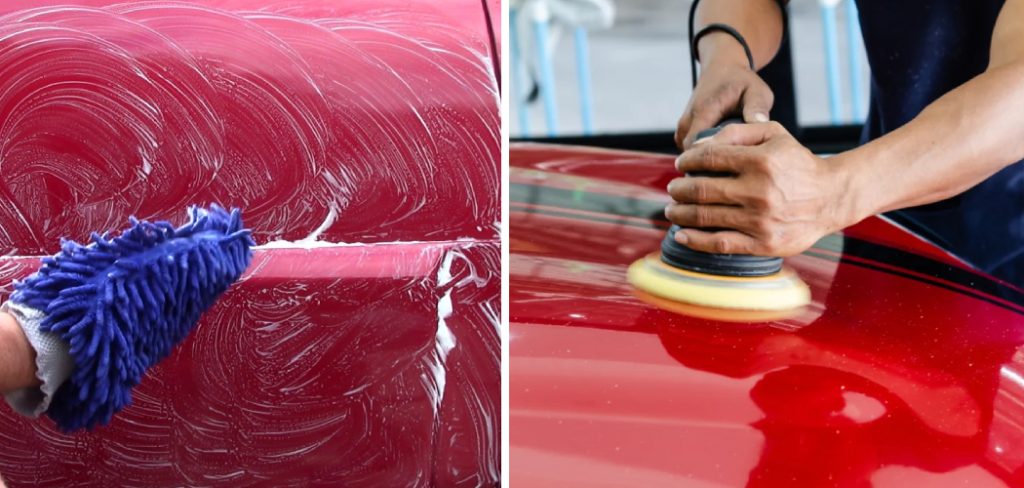
Proper removal techniques ensure that the car’s paint remains unharmed, restoring its aesthetic appeal and making way for a new layer of protection. In the following sections, we’ll guide you on how to remove wax from car paint step-by-step through the most effective methods to safely strip wax from your car’s paint.
What is a Car Wax?
Car wax is a protective coating applied to the surface of a vehicle’s paint after washing and polishing. It acts as a barrier against external elements such as UV rays, dust, dirt, and water while also giving your car a glossy finish.
Over time, though, this layer of wax breaks down and forms an unsightly buildup that can be challenging to remove. The residue can also cause paint discoloration and diminish the shine of your car’s exterior. You need to remove the old wax before applying a new coat for maximum protection and shine.
Why is it Important to Remove Wax from Car Paint?
Leaving old wax on your car’s paint can result in a dull and hazy appearance, making your vehicle look older and unkempt. The residue can also attract dirt and dust, further diminishing the shine of your car’s paint.
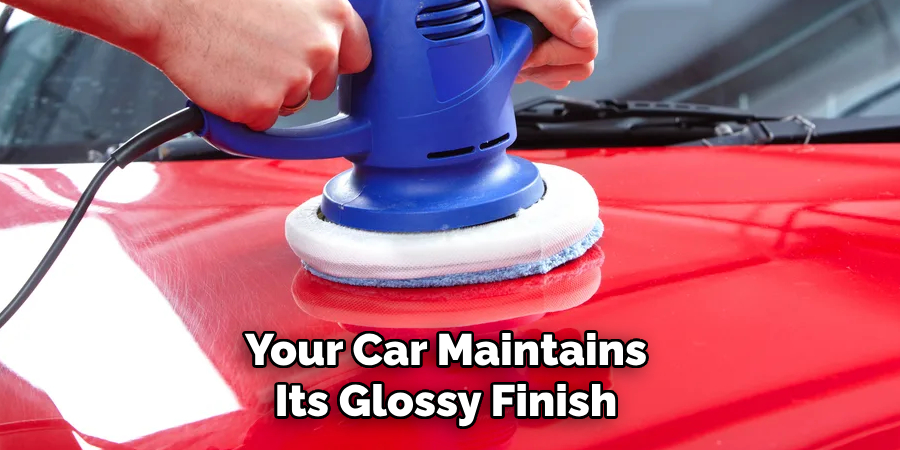
Removing the wax buildup before reapplying a new coat will ensure that your car maintains its glossy finish and remains protected from external elements. You should also remove any accidental wax overlay on adjacent surfaces to avoid permanent discoloration and maintain a uniform appearance.
Common Causes of Wax Buildup
- Overapplication of Wax During Polishing
- Using the Wrong Type of Wax for Your Car’s Paint
- Not Removing Old Wax Before Applying a New Coat
- Wax Overlay on Non-painted Surfaces, Such as Plastic or Rubber Trim
- Using Low-quality Wax Products That Leave Behind Sticky Residue
- Not Properly Buffing or Wiping Off Excess Wax After Application
Tools and Materials Needed
To remove wax from car paint, you’ll need the following tools and materials:
Microfiber Towels or Clothes
These are essential in the cleaning and drying process. Microfiber towels are highly absorbent and gentle on car paint, ensuring scratch-free removal.
Clay Bar
A clay bar is an ideal tool for removing tough wax residue that has bonded with your car’s paint over time. It gently removes contaminants while leaving the paint intact.
Automotive Detailing Cleaner
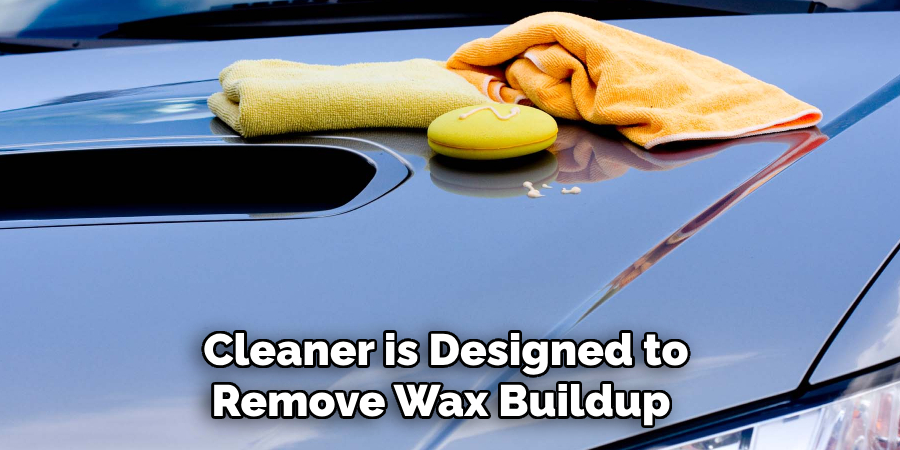
This specialized cleaner is designed to remove wax buildup and other residues from car paint without damaging the surface.
Car Shampoo
A gentle car shampoo, preferably pH neutral, helps loosen and dissolve the wax buildup on your car’s exterior. It also helps in lubricating the surface, making it easier to remove the residue.
Soft Bristle Brush
You can use a soft-bristled brush to gently remove the wax from tight areas like around car emblems and side mirrors.
Rubbing Alcohol or Isopropyl
Rubbing alcohol is a common household solvent that can effectively remove wax from car paint. It can also be used to clean hard-to-reach areas of your vehicle’s exterior.
11 Step-by-step Guidelines on How to Remove Wax From Car Paint
Step 1: Choosing the Appropriate Wax Remover.
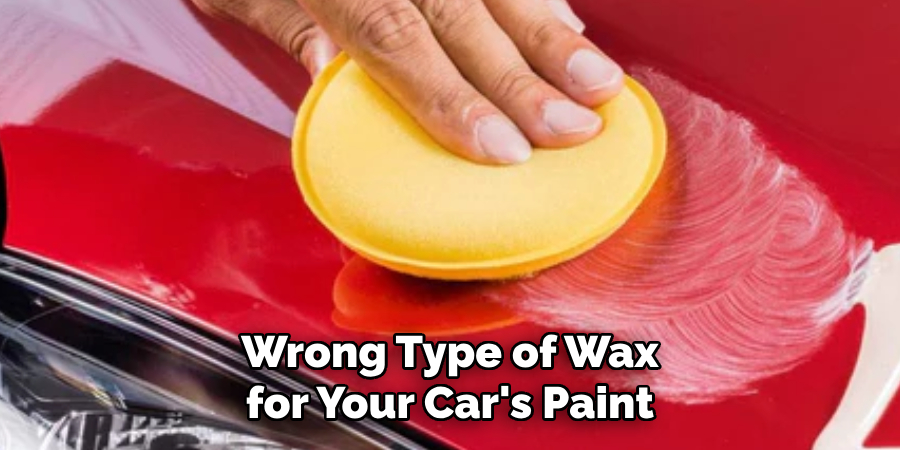
As mentioned earlier, using the wrong type of wax for your car’s paint can lead to buildup and other complications. Before removing the wax, ensure that you have a safe and effective wax remover suitable for your vehicle’s exterior.
The type of wax remover you need may depend on the age and condition of your car’s paint. It’s good to consult a professional or read product reviews before choosing a wax remover. But if you’re using a clay bar, skip to step 4.
Step 2: Park Your Car in a Shaded Area and Allow it to Cool Down.
Heat from the sun can cause the wax remover to evaporate quickly, making it less effective. Parking your car in a shaded area will also prevent any water or cleaner residue from drying on the surface, which can cause further damage.
It’s also crucial to let your car cool down before starting the wax removal process. You don’t want to burn yourself on hot surfaces, and the wax may also be easier to remove when it’s not warm. The ideal temperature for removing wax is between 60 and 80 degrees Fahrenheit.
Step 3: Wash Your Car With a Gentle Car Shampoo.
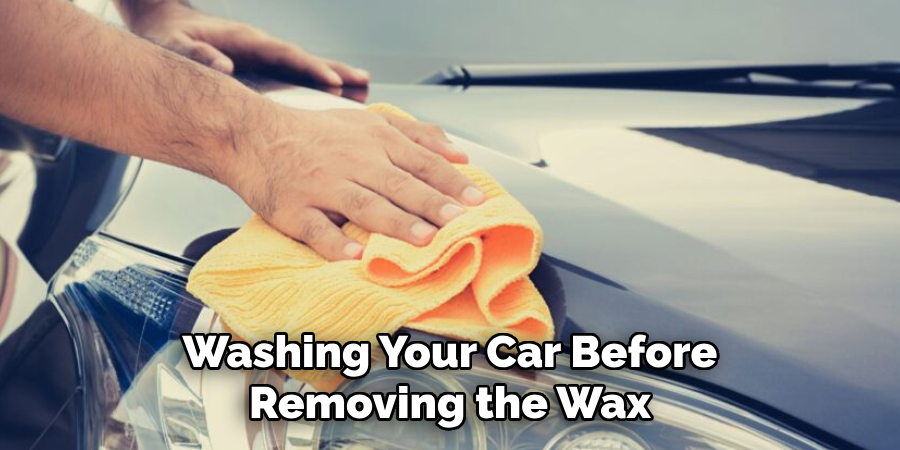
Washing your car before removing the wax will help loosen and dissolve any loose residue. Use a gentle car shampoo and a microfiber towel to avoid scratching your vehicle’s paint. Rinse thoroughly and dry the surface with another clean towel.
If you’re using a clay bar, skip to step 5. You can also use a detailing cleaner at this stage, but make sure to follow the product’s instructions. It’s good practice to clean your car before and after waxing.
Step 4: Use a Clay Bar to Remove the Wax.
A clay bar is an excellent tool for removing bonded wax residues and other contaminants on your car’s paint. Before using it, ensure that you have washed your car thoroughly and removed any loose dirt or dust. Knead the clay bar into a flat shape, then lubricate the surface with water or a detailing spray.
Gently rub the clay bar over the affected areas in a back-and-forth motion. When you start to feel less resistance, fold the clay bar and continue using a clean side until it becomes too dirty. Repeat this process until the clay bar glides smoothly over the surface. Once done, wipe away any residue with a microfiber towel.
Step 5: Apply Wax Remover or Rubbing Alcohol.
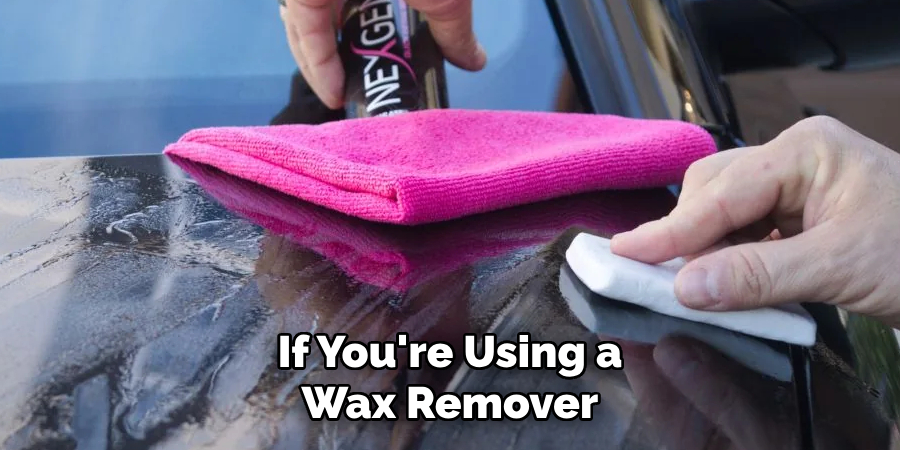
If you’re using a wax remover, follow the product’s instructions and apply it to the affected areas using a clean microfiber towel. If you’re using rubbing alcohol, dampen a cloth with it and gently rub it over the residue until it starts to dissolve.
It’s essential to work in small sections so the solvent doesn’t have time to dry. You can also use a soft-bristled brush for tight areas if needed. The residue should start to come off easily. It’s good practice to wipe the area with a microfiber towel as you work to avoid any residue from drying on the surface.
Step 6: Wipe Off the Residue.
Using a clean microfiber towel, gently wipe away the wax residue until it’s completely removed. You may need to use multiple towels if the buildup is excessive. Don’t press too hard as this can cause scratches on your car’s paint. It’s also essential to use a new towel or fold it to a clean side regularly.
However, if the towel becomes too dirty, switch to a new one. It’s important to remove all the residue; otherwise, it may cause further damage or interfere with future wax applications. The surface should now feel smooth and clean.
Step 7: Rinse and Dry the Surface.
Rinse the surface with clean water or a detailing spray. Inspect for any remaining residue and repeat the previous steps if needed. Once all wax buildup is removed, dry the surface thoroughly with a microfiber towel.
The surface should now be clean and ready for a fresh coat of wax. The surface should also feel smooth and free of any residue. It’s essential to dry the surface entirely before applying wax; otherwise, it may not bond properly.
Step 8: Apply a Fresh Coat of Wax.
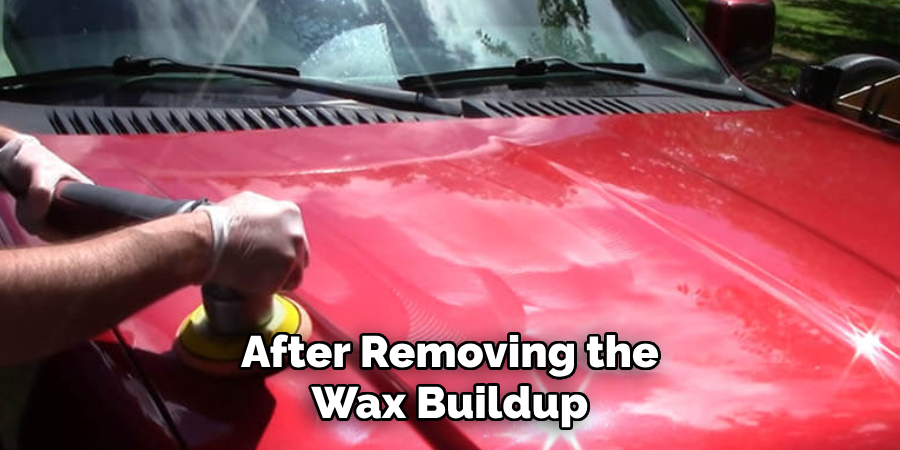
After removing the wax buildup, it’s time to reapply a fresh coat of wax to protect your car’s paint and give it a shiny finish. Choose a high-quality wax product suitable for your car’s paint type and follow the instructions carefully. You can use a soft applicator pad or cloth to apply the wax evenly, working in small sections.
Allow the wax to dry before buffing it off with a clean microfiber towel. However, if you’re using a spray wax, follow the product’s instructions. Although spray wax can be applied to a wet or dry surface, it’s recommended to use it on a clean and dry one.
Step 9: Buff for a High Shine Finish.
Once the wax has dried, buff it off in circular motions with a clean microfiber towel. This step helps to smooth out any imperfections and enhance shine. You can also use a separate buffing pad or a dual-action polisher for an even better finish.
But be careful not to buff too hard as this can cause scratches. If you’re using a spray wax, make sure to buff it off as well. The result should be a shiny and protected surface free of wax buildup.
Step 10: Apply Wax Regularly and Maintain Your Car’s Exterior.
To prevent future wax buildup, it’s essential to apply wax regularly and maintain your car’s exterior. Experts recommend waxing your car every three months, but this may vary depending on factors such as climate and driving conditions.
Regular washing with a gentle car shampoo and using detailing cleaners as needed can also help keep your car’s paint in good condition. You can also consider using a ceramic coating for long-lasting protection against wax buildup and other contaminants.
Step 11: Seek Professional Help if Needed.
Removing excessive wax buildup may require professional assistance if you’re not confident or experienced enough to do it yourself. A professional detailing service can safely and effectively remove the wax without causing damage to your car’s paint.
They also have access to specialized tools and products that may be more effective in removing stubborn residue. Consider seeking their help if you’re unsure about the process or want a professional finish for your car’s exterior.
Overall, regular maintenance and proper techniques can help keep your car’s exterior looking clean and shiny while protecting it from the damage of wax buildup.
With these steps on how to remove wax from car paint in mind, you can confidently take on the task of removing wax buildup and maintaining your car’s appearance. Now go out and enjoy that freshly cleaned ride! So remember to always follow best practices when dealing with wax.
Do You Need to Use Professionals?
While it is possible to remove wax buildup from your car’s paint by yourself, there may be instances where professional help is needed. If the wax buildup is excessive or if you are unsure about the process, it may be best to seek assistance from a professional detailing service.
They have the experience and tools necessary to safely and effectively remove wax without causing damage to your car’s paint. It’s also a good idea to seek professional help if you want a flawless finish or if your car’s exterior needs more extensive detailing. In any case, it’s always best to err on the side of caution and trust the experts when needed. So don’t hesitate to seek their help if needed.
How Much Will It Cost?
The cost of removing wax buildup from your car’s paint may vary depending on the extent of the buildup and the professional you choose to work with. It’s best to inquire about pricing before hiring a detailing service and make sure to ask for any additional fees that may apply.
You can also check reviews and ask for recommendations from friends or family to find a trusted and reasonably priced detailing service in your area.
Remember, a higher cost doesn’t always mean better quality, so it’s important to do your research before choosing a professional for this task. If you decide to do it yourself, the cost will be significantly lower, but keep in mind that you may need to invest in some products and tools to properly remove the wax buildup.
It’s also a good idea to have a professional inspection if you’re unsure about the process or are dealing with excessive wax buildup on your car’s paint.
Frequently Asked Questions
Q: Can I Use a Household Cleaner to Remove Wax From Car Paint?
A: It’s not recommended to use general household cleaners on your car’s paint as they can be harsh and strip the protective layer. Stick to automotive detailing cleaners for best results. The same goes for using abrasive tools such as kitchen sponges or steel wool, which can cause scratches on the paint.
Q: How Often Should I Apply Wax to My Car?
A: Experts recommend waxing your car every three months, but this may vary depending on factors such as climate and driving conditions. It’s generally a good idea to apply wax after washing your car to maintain the protective layer and keep the paint looking shiny.
Q: How Do I Know if My Car Needs Waxing or Just Cleaning?
A: If you notice that water doesn’t bead up on your car’s surface as it used to, it’s a sign that the wax needs to be reapplied. Also, if you notice that the paint is looking dull or has a rough texture, it may be time for a deep cleaning and waxing.
Q: Can I Remove Wax Buildup Without Using Solvents?
A: Yes, you can try using a detailing clay bar to remove wax buildup without the use of solvents. However, it may not be as effective on stubborn residue, and you may still need to use a solvent-based cleaner for best results.
Q: Are There Any Alternative Methods for Removing Wax Buildup?
A: Some people swear by using hot steam to loosen and remove wax buildup from car paint. However, this method may not be suitable for all types of paint and can potentially cause damage if not done correctly. It’s best to stick to tried-and-tested methods or seek professional help in these cases.
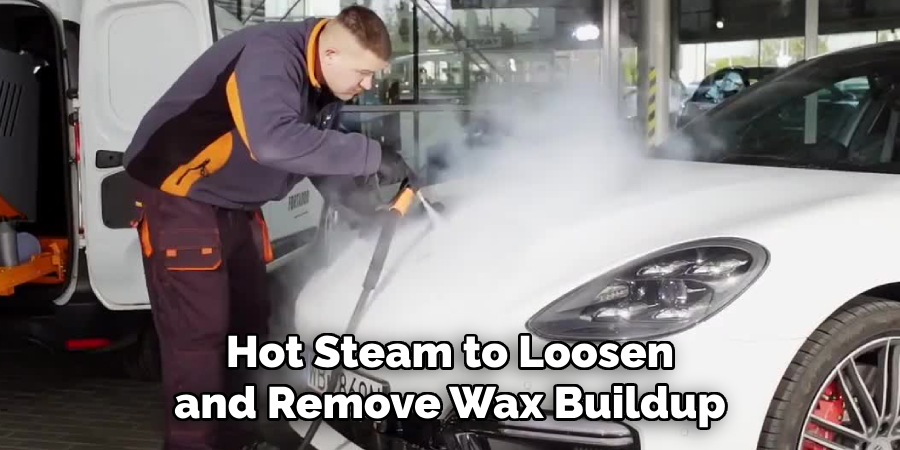
So there you have it, everything you need to know about removing wax buildup from car paint. Whether you choose to do it yourself or seek professional help, remember to always follow best practices and use the right products for your car’s specific needs. By regularly maintaining your car’s exterior and using proper techniques, you can keep your ride looking shiny and new for years to come.
Conclusion
In summary, the success of removing wax from car paint hinges on using the right products and techniques to ensure the vehicle’s surface is treated with care. Whether employing a commercial wax remover, detailing clay, or a mixture of vinegar and water, the key is to work gently and methodically.
By following the steps on how to remove wax from car paint outlined above, you can effectively eliminate wax residue and keep your car’s finish looking its best. Remember, regular care and proper maintenance are your best defenses against wax buildup and will help preserve the shine and integrity of your car’s paint for years to come.
You Can Check it Out to Clean Bird Poop Off Windshield

About
JeepFixes Team is a skilled author for Jeep Fixes, bringing 6 years of expertise in crafting a wide range of jeep fixes. With a strong background in jeep fixes work, JeepFixes Team’s knowledge spans various types of fixtures, from decorative pieces to functional hardware, blending precision with creativity. His passion for jeep fixes and design has made him a trusted resource in the industry.
Professional Focus:
Expert in Jeep Fixes : JeepFixes Team aesthetic specializes in creating durable and innovative jeep fixes, offering both appeal and functionality. His work reflects a deep understanding of jeep fixes techniques and materials.
Sustainability Advocate : He is dedicated to using sustainable practices, ensuring that every fixture is crafted with eco-friendly methods while maintaining high-quality standards.
In his writing for jeep fixes, JeepFixes Team provides valuable insights into the latest trends, techniques, and practical advice for those passionate about jeep fixes, whether they are professionals or DIY enthusiasts. His focus on combining artistry with engineering helps others discover the true potential of jeep in design.
